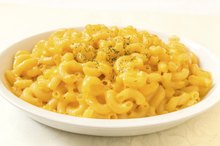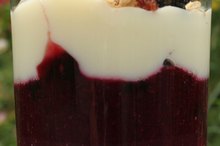Foods Containing Sodium Acetate
Sodium acetate is used in a number of industries: as a buffer in the petroleum production, a retardant in the plastic production and is an intermediate in the production of dyes, pigments, soaps and pharmaceuticals (see Reference 1) 1. In the food industry, sodium acetate is added to many foods as an acidity regulator, emulsifier and preservative according to the Food and Agriculture Organization of the United Nations (see Reference 2) 1. Sodium acetate is also generally recognized as safe, or GRAS, by the U.S. Department of Agriculture 1. (see Reference 3). The GSFA online food database has an extensive list of foods containing sodium acetate and a few categories are described below (all from Reference 2) 12.
Processed Cheeses and Dairy
Sodium acetate is predominantly used as an emulsifier and preservative in processed cheeses and dairy 1. It is used in most cheese preparations including ripened cheeses, processed cheese and cheese analogues such as imitation cheese and cheese powders. Dairy products that may contain sodium acetate include sour cream, buttermilk, yogurt, condensed milk and any dairy or whey-based drinks 1. Reading the ingredient label of any cheese or dairy product is the best way to determine if sodium acetate is added 1.
Processed Fruits and Vegetables
Fumaric Acid Foods
Learn More
When fruits and vegetables are processed by methods such as canning or drying, sodium acetate may be added as an acidity regulator to prevent the growth of dangerous bacteria in addition to acting as a preservative 1. Additionally, nut and seed spreads such as peanut butter and preserved legumes such as beans and lentils may have sodium acetate added 1. Again, the best way you can check for sodium acetate is to look at the ingredient label of any packaged or canned fruit or vegetable product 1.
Processed Meats and Fish
Processed meat or poultry such as deli meats, canned meat and even the edible casings on sausages may have sodium acetate added as a preservative 1. Fish that are fermented or canned may also have sodium acetate added to prevent bacterial growth and promote longer shelf life 1. Examples include canned sardines, fish pastes and other types of fermented shellfish often found in Asian cooking.
Commercially-Prepared Desserts
Foods Containing Calcium Propionate
Learn More
You may be surprised to learn how many different desserts contain sodium acetate either as an emulsifier or preservative 1. Egg-based desserts such as custards, dairy-based treats like ice cream and pudding and confectionery foods like chocolate, candies and icing all could have sodium acetate added 1. Even edible ices like sherbet or sorbet may include it! As always, you can check out the ingredient label to see if your favorite treat has sodium acetate added 1.
Liquid Seasonings and Condiments
If you enjoy packaged salt and vinegar chips, it might surprise you to learn that it may be sodium acetate providing that slightly tangy flavor rather than real salt and vinegar 1. In addition to these chips, sodium acetate may be used in a number of condiments including vinegar, mustard, broths, soups, sauces and fat-based spreads like margarine and butter blends 1. Its function in condiments depends on the product, ranging from an emulsifier in mustard and sauces to a preservative in fat-based spreads.
Related Articles
References
Writer Bio
Jason Machowsky is a registered dietitian and certified personal trainer who began writing in 2010. He has been published at LIVESTRONG.com, specializing in nutrition- and fitness-related topics. He has personal training experience at Equinox Fitness and New York Sports Clubs and a Master of Science in applied physiology and nutrition from Columbia University.









